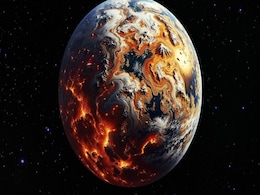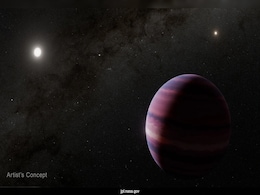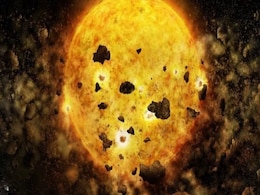Giant Planets
- All
- News
- Videos
-

Uranus and Neptune May Be Rock-Dominated Planets, Study Suggests
- Saturday December 13, 2025
Uranus and Neptune may not be true ice giants after all. New research using advanced hybrid simulations suggests the distant planets could be dominated by rocky material rather than water-rich ices. The findings challenge decades of planetary models and may help explain the planets’ unusual, non-dipolar magnetic fields. Scientists say future dedi...
-
 www.gadgets360.com
www.gadgets360.com
-

Uranus and Neptune May Be Rocky Worlds Not Ice Giants, New Research Shows
- Thursday December 11, 2025
A new analysis challenges decades-old assumptions about Uranus and Neptune, revealing that both planets may contain far more rock than icy materials. These findings help explain their strange magnetic fields and show that traditional "ice giant" models may be incomplete. Scientists say only dedicated future missions can uncover the true interior ma...
-
 www.gadgets360.com
www.gadgets360.com
-

James Webb Space Telescope Spots an Exoplanet Losing Its Atmosphere in a Huge Helium Stream
- Thursday December 4, 2025
Astronomers using NASA’s James Webb Space Telescope have observed a massive helium cloud escaping from the super-puff exoplanet WASP-107b, marking the first direct detection of such atmospheric loss. Webb’s infrared data reveal an enormous exosphere nearly ten times the planet’s radius, with helium streaming both ahead of and behind the plane...
-
 www.gadgets360.com
www.gadgets360.com
-

NASA's Astronomers Reveal Red Giant Stars May Destroy Their Own Planets
- Monday November 10, 2025
- Science |
This extreme expansion poses a serious threat to nearby planets. For example, when the Sun becomes a red giant in about 5 billion years, it will likely swallow Mercury and Venus.
-
 www.ndtv.com
www.ndtv.com
-

One Of The World's Rarest Whales Grows In Population In The Atlantic
- Tuesday October 21, 2025
- World News |
One of the rarest whales on the planet has continued an encouraging trend of population growth in the wake of new efforts to protect the giant animals, according to scientists who study them.
-
 www.ndtv.com
www.ndtv.com
-

MIT Detects Traces of a Lost ‘Proto Earth’ Deep Beneath Our Planet’s Surface
- Monday October 20, 2025
MIT researchers have discovered rare isotopic traces of a “proto Earth” that existed before the giant impact that shaped our modern planet. Found deep in ancient rocks, these potassium isotope signatures reveal remnants of Earth’s earliest material, offering fresh insight into the planet’s formation and the solar system’s earliest history...
-
 www.gadgets360.com
www.gadgets360.com
-

Astronomers Capture First-Ever Image Of A Baby Planet Forming In Real Time
- Tuesday October 7, 2025
- Science |
Astronomers have made a groundbreaking discovery by directly observing a young protoplanet, WISPIT 2b, embedded in a ring-shaped gap in a disk around a young star.
-
 www.ndtv.com
www.ndtv.com
-

Exoplanets Explained: How Astronomers Find Worlds Orbiting Stars Beyond the Sun
- Monday September 8, 2025
Exoplanets are planets orbiting stars outside our solar system, hidden by stellar glare and detected indirectly. Astronomers identify them by tracking star wobbles or dips in brightness during planetary transits. NASA’s Kepler mission revealed thousands, with TESS now expanding the search. These discoveries confirm that planetary systems are abun...
-
 www.gadgets360.com
www.gadgets360.com
-

A Planet Is Being Born: Astronomers Capture Rare Cosmic Snapshot
- Saturday August 30, 2025
Astronomers have captured a groundbreaking sight: WISPIT 2b, a baby gas giant planet forming within a dusty, multi-ring protoplanetary disk around a young Sun-like star 430 light-years away. Infrared images from the Very Large Telescope show the planet carving a dark path in the rings as it feeds on gas and dust. This rare discovery provides the fi...
-
 www.gadgets360.com
www.gadgets360.com
-

EV Giant BYD Seeks To Shift Mass Market Image With Souped-Up Race Track
- Monday August 25, 2025
- World News | Bloomberg News
The name BYD Co. is mainly associated with mass market electric vehicles. A manufacturing behemoth that churns out more electric cars than anyone else on the planet, its a brand built on volume and affordability.
-
 www.ndtv.com
www.ndtv.com
-

A New 'Earth' Next Door? Scientists Detect Possible Habitable Planet Around Closest Sun-Like Star
- Friday August 15, 2025
- Science |
Astronomers using JWST have detected a giant exoplanet in the habitable zone of Alpha Centauri A, our nearest Sun-like star.
-
 www.ndtv.com
www.ndtv.com
-

James Webb Telescope Detects Potential Gas Giant Exoplanet Just 4 Light-Years Away
- Friday August 8, 2025
Astronomers using JWST have spotted a possible gas giant orbiting Alpha Centauri A, only 4 light-years away. If confirmed, it would be the closest exoplanet to a Sun-like star ever imaged. The discovery could challenge current models of planetary formation in binary systems and open new opportunities for studying nearby worlds.
-
 www.gadgets360.com
www.gadgets360.com
-

Doomed Exoplanet TOI-2109b Spirals Toward Its Star with Three Possible Fates
- Monday July 28, 2025
The gas giant TOI-2109b, over five times Jupiter’s mass, is spiraling closer to its star in a rare planetary death spiral. With a 16-hour orbit and blistering heat, the exoplanet could either plunge into its host star, be torn apart by tidal forces, or evolve into a rocky super-Earth through photoevaporation. NASA’s TESS and ESA’s Cheops data...
-
 www.gadgets360.com
www.gadgets360.com
-

Giant Trolls Built From Trash Want To Save Humans From Themselves
- Wednesday July 23, 2025
- World News |
Nestled in forests around the world, a gentle army of giant wooden trolls want to show humans how to live better without destroying the planet
-
 www.ndtv.com
www.ndtv.com
-

Young Exoplanet Spotted Shedding Atmosphere Under Stellar Radiation
- Thursday July 17, 2025
NASA’s Chandra X-ray Observatory and Hubble Space Telescope have captured a dramatic cosmic event: a baby exoplanet, TOI 1227 b, is being stripped of its atmosphere by powerful X-rays from its host star. Only 8 million years old and orbiting a red dwarf, this Jupiter-sized planet is losing gas at a rate equal to Earth’s entire atmosphere every ...
-
 www.gadgets360.com
www.gadgets360.com
-

Uranus and Neptune May Be Rock-Dominated Planets, Study Suggests
- Saturday December 13, 2025
Uranus and Neptune may not be true ice giants after all. New research using advanced hybrid simulations suggests the distant planets could be dominated by rocky material rather than water-rich ices. The findings challenge decades of planetary models and may help explain the planets’ unusual, non-dipolar magnetic fields. Scientists say future dedi...
-
 www.gadgets360.com
www.gadgets360.com
-

Uranus and Neptune May Be Rocky Worlds Not Ice Giants, New Research Shows
- Thursday December 11, 2025
A new analysis challenges decades-old assumptions about Uranus and Neptune, revealing that both planets may contain far more rock than icy materials. These findings help explain their strange magnetic fields and show that traditional "ice giant" models may be incomplete. Scientists say only dedicated future missions can uncover the true interior ma...
-
 www.gadgets360.com
www.gadgets360.com
-

James Webb Space Telescope Spots an Exoplanet Losing Its Atmosphere in a Huge Helium Stream
- Thursday December 4, 2025
Astronomers using NASA’s James Webb Space Telescope have observed a massive helium cloud escaping from the super-puff exoplanet WASP-107b, marking the first direct detection of such atmospheric loss. Webb’s infrared data reveal an enormous exosphere nearly ten times the planet’s radius, with helium streaming both ahead of and behind the plane...
-
 www.gadgets360.com
www.gadgets360.com
-

NASA's Astronomers Reveal Red Giant Stars May Destroy Their Own Planets
- Monday November 10, 2025
- Science |
This extreme expansion poses a serious threat to nearby planets. For example, when the Sun becomes a red giant in about 5 billion years, it will likely swallow Mercury and Venus.
-
 www.ndtv.com
www.ndtv.com
-

One Of The World's Rarest Whales Grows In Population In The Atlantic
- Tuesday October 21, 2025
- World News |
One of the rarest whales on the planet has continued an encouraging trend of population growth in the wake of new efforts to protect the giant animals, according to scientists who study them.
-
 www.ndtv.com
www.ndtv.com
-

MIT Detects Traces of a Lost ‘Proto Earth’ Deep Beneath Our Planet’s Surface
- Monday October 20, 2025
MIT researchers have discovered rare isotopic traces of a “proto Earth” that existed before the giant impact that shaped our modern planet. Found deep in ancient rocks, these potassium isotope signatures reveal remnants of Earth’s earliest material, offering fresh insight into the planet’s formation and the solar system’s earliest history...
-
 www.gadgets360.com
www.gadgets360.com
-

Astronomers Capture First-Ever Image Of A Baby Planet Forming In Real Time
- Tuesday October 7, 2025
- Science |
Astronomers have made a groundbreaking discovery by directly observing a young protoplanet, WISPIT 2b, embedded in a ring-shaped gap in a disk around a young star.
-
 www.ndtv.com
www.ndtv.com
-

Exoplanets Explained: How Astronomers Find Worlds Orbiting Stars Beyond the Sun
- Monday September 8, 2025
Exoplanets are planets orbiting stars outside our solar system, hidden by stellar glare and detected indirectly. Astronomers identify them by tracking star wobbles or dips in brightness during planetary transits. NASA’s Kepler mission revealed thousands, with TESS now expanding the search. These discoveries confirm that planetary systems are abun...
-
 www.gadgets360.com
www.gadgets360.com
-

A Planet Is Being Born: Astronomers Capture Rare Cosmic Snapshot
- Saturday August 30, 2025
Astronomers have captured a groundbreaking sight: WISPIT 2b, a baby gas giant planet forming within a dusty, multi-ring protoplanetary disk around a young Sun-like star 430 light-years away. Infrared images from the Very Large Telescope show the planet carving a dark path in the rings as it feeds on gas and dust. This rare discovery provides the fi...
-
 www.gadgets360.com
www.gadgets360.com
-

EV Giant BYD Seeks To Shift Mass Market Image With Souped-Up Race Track
- Monday August 25, 2025
- World News | Bloomberg News
The name BYD Co. is mainly associated with mass market electric vehicles. A manufacturing behemoth that churns out more electric cars than anyone else on the planet, its a brand built on volume and affordability.
-
 www.ndtv.com
www.ndtv.com
-

A New 'Earth' Next Door? Scientists Detect Possible Habitable Planet Around Closest Sun-Like Star
- Friday August 15, 2025
- Science |
Astronomers using JWST have detected a giant exoplanet in the habitable zone of Alpha Centauri A, our nearest Sun-like star.
-
 www.ndtv.com
www.ndtv.com
-

James Webb Telescope Detects Potential Gas Giant Exoplanet Just 4 Light-Years Away
- Friday August 8, 2025
Astronomers using JWST have spotted a possible gas giant orbiting Alpha Centauri A, only 4 light-years away. If confirmed, it would be the closest exoplanet to a Sun-like star ever imaged. The discovery could challenge current models of planetary formation in binary systems and open new opportunities for studying nearby worlds.
-
 www.gadgets360.com
www.gadgets360.com
-

Doomed Exoplanet TOI-2109b Spirals Toward Its Star with Three Possible Fates
- Monday July 28, 2025
The gas giant TOI-2109b, over five times Jupiter’s mass, is spiraling closer to its star in a rare planetary death spiral. With a 16-hour orbit and blistering heat, the exoplanet could either plunge into its host star, be torn apart by tidal forces, or evolve into a rocky super-Earth through photoevaporation. NASA’s TESS and ESA’s Cheops data...
-
 www.gadgets360.com
www.gadgets360.com
-

Giant Trolls Built From Trash Want To Save Humans From Themselves
- Wednesday July 23, 2025
- World News |
Nestled in forests around the world, a gentle army of giant wooden trolls want to show humans how to live better without destroying the planet
-
 www.ndtv.com
www.ndtv.com
-

Young Exoplanet Spotted Shedding Atmosphere Under Stellar Radiation
- Thursday July 17, 2025
NASA’s Chandra X-ray Observatory and Hubble Space Telescope have captured a dramatic cosmic event: a baby exoplanet, TOI 1227 b, is being stripped of its atmosphere by powerful X-rays from its host star. Only 8 million years old and orbiting a red dwarf, this Jupiter-sized planet is losing gas at a rate equal to Earth’s entire atmosphere every ...
-
 www.gadgets360.com
www.gadgets360.com

















